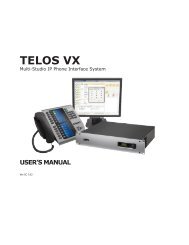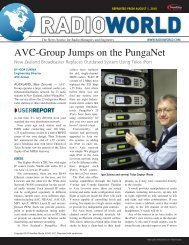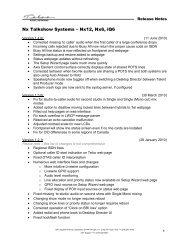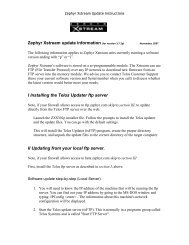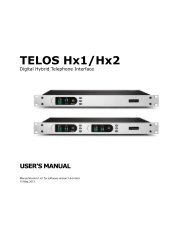NOW! 12-13 - Telos
NOW! 12-13 - Telos
NOW! 12-13 - Telos
Create successful ePaper yourself
Turn your PDF publications into a flip-book with our unique Google optimized e-Paper software.
AXIA | NETWORKING | TECHNOLOGY ARTICLE<br />
100<br />
AoIP IN BROADCAST ENGINEERING<br />
» Livewire’s patented synchronization iltering algorithm in<br />
slave devices ensures exceptional stability in presence of<br />
network jitter, and works equally well both with the original<br />
Livewire sync protocol and the IEEE 1588 (PTP) standard. Un-<br />
der certain conditions, Livewire networks can achieve better<br />
sync performance than IEEE 1588 alone would deliver.<br />
» IP multicast-based routing ensures eficient one-to-many<br />
connectivity, as well as instant setting up, rerouting, and<br />
clearing of individual connections.<br />
» Advanced device and source discovery protocol ensures<br />
RAVENNA<br />
instant availability of dynamically changing data through-<br />
out the network.<br />
RAVENNA (an acronym for Real-time Audio Video Enhanced<br />
Next-generation Networking Architecture) is a new offering<br />
from Lawo, the German manufacturer of ultra-high end broadcast<br />
consoles. Just recently they have started to demonstrate<br />
real device prototypes.<br />
From the fundamental technology viewpoint, in the area of pro<br />
audio, RAVENNA is actually making a second round on the basis<br />
of IETF documents. Although it has its own independent roots,<br />
this effort essentially results in a generalization of the Livewire<br />
solution. RAVENNA follows exactly the same way of thinking as<br />
does Livewire, which is to say that it is aimed at building open<br />
systems on the basis of widely adopted public standards – so<br />
it’s not a surprise that they, too, are building their technology<br />
on IP, UDP, RTP, and the related protocols.<br />
There is a difference in the business model though:<br />
» The Livewire project has been focused on bringing a practi-<br />
cal solution to market since its very inception. It was pri-<br />
marily designed for a speciic product line, although fully<br />
recognizing the value of being standards-based and open.<br />
The focus on a product resulted in selecting a technically<br />
suficient, and at the same time economically justiied,<br />
functionality set. This precisely deined functionality is con-<br />
sistently supported across the entire Livewire product line,<br />
ensuring universal interoperability.<br />
» Unlike Livewire, RAVENNA started from offering a highly<br />
generic speciication, which taken alone can not effectively<br />
ensure multi-vendor interoperability due to too many vari-<br />
ables that are left unresolved in the framework. This will be<br />
addressed by means of providing precisely deined interop-<br />
erability proiles – a work currently in progress.<br />
As to the actual technical differences in the application overlap<br />
area, there is not much to speak about. Besides allowing multiple<br />
interoperability proile deinitions, the biggest difference<br />
is the selection of a synchronization method. While Livewire<br />
uses its own synchronization protocol, RAVENNA has selected<br />
the IEEE 1588 (PTP) standard, which simply did not exist yet at<br />
the time Livewire was developed. However, today even this difference<br />
starts to disappear, as Livewire has introduced support<br />
for IEEE 1588 beginning with the debut of Axia’s xNodes. And of<br />
course, Livewire retains the option for users to operate with its<br />
original sync protocol as well.<br />
To put all this into context, in terms of the RAVENNA framework,<br />
the audio streaming part of Livewire would correspond<br />
to a speciic proile. Paradoxically, if such a proile were deined,<br />
at the time this is written, Livewire would be the only existing<br />
RAVENNA proile that is implemented in real products, widely<br />
deployed and ield-proven.<br />
There is also open speciication work in progress yet, especially<br />
at the higher application layers of RAVENNA.<br />
OTHER AoIP TECHNOLOGIES?<br />
Thanks to the popularity of Livewire, some companies have<br />
announced their own competing AoIP protocols, but these are<br />
closed, proprietary solutions, and information about them is<br />
limited. None have achieved wide acceptance in broadcasting.<br />
» Dante: 100Mb or Gigabit Ethernet, IEEE 1588-2002, UDP<br />
unicast or multicast, 48/96/192kHz sampling rates, 24-bit<br />
proprietary coding, Bonjour discovery<br />
» Q-LAN: Gigabit Ethernet or higher, IEEE 1588-2002, UDP<br />
unicast, 48kHz sampling rate, 32-bit loating proprietary<br />
coding, proprietary discovery protocol<br />
» WheatNet: Gigabit Ethernet, UDP multicast, 48/44.1kHz<br />
sampling rate, 24-bit RTP coding<br />
THIS IS NOT AoIP!<br />
Ethernet is not AoIP. Probably the biggest point of confusion<br />
for those seeking an AoIP solution is confusing Ethernet with<br />
IP, since they are nearly inseparable. But there is a signiicant<br />
difference between technologies built on the IP layer (layer 3)<br />
and those implemented directly on the Ethernet data link layer<br />
(layer 2), or even the Ethernet physical layer. The biggest difference<br />
is that non-IP technologies are not routable, signiicantly<br />
limiting their usefulness.<br />
For example, none of these otherwise great technologies are<br />
AoIP, even though they use an Ethernet transmission link:<br />
» Cobranet – legendary for its time and niche, but it is an Eth-<br />
ernet layer-2 technology<br />
» AES50 – Ethernet layer-1<br />
» Ethersound – Ethernet layer-2<br />
» AVB – Ethernet layer-2<br />
AVB is not AoIP. Surprised by this? Even with the understanding<br />
that AVB is not AoIP, it is often touted as a possible replacement,<br />
or even a superior technology. While AVB is a great<br />
advancement in the area of audio streaming, designed to deliver<br />
high-resolution audio at a guaranteed low latency, it’s a pretty<br />
tricky proposition for the system engineer willing to build an<br />
AVB application.



